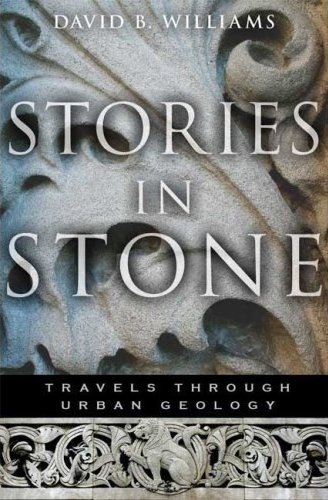
Stories in Stone: Travels Through Urban Geology
by David B. Williams
-Reviewed by Jodie Liu
Natural history writer David Williams always appreciated the magnificent red sandstone formations of southern Utah. But it wasn’t until he moved to Boston, full of apartment complexes and commercial buildings, that Williams became fascinated with geology. As it turns out, Boston’s stonemasonry helped Williams realize that, like naturally formed rocks, the stones we use in urban settings reveal layers of history.
Much like the buildings he examines, Williams’s work is built from stones, each chapter paying homage to a different type of rock and its cultural legacy. Williams turns each stone over and over, reading into geological origins, exposing social history, and discussing the cultural ramifications of the stone’s use. Williams shows, for example, how brownstone – thanks to its abundance at Connecticut quarry site and the ease of extracting it from the earth – overcame its original reputation as “the most hideous stone ever quarried” to adorn some of New York City’s most stately homes. And he is fascinated by a clamshell-ridden stone that coated a 16th century Spanish fortress in St. Augustine, Florida because of its unique ability to deflect bullets – discovered not during construction, but rather during a failed siege attempt by the American colonies.
Williams also humanizes stone, particularly in his exploration of poet Robinson Jeffers and his almost religious affinity with stone. Jeffers had long slipped under the radar as “an insecure, mediocre writer.” But when he finally married his longtime love Una, moved to Carmel to start a family, and decided to build a house entirely of giant chunks of Carmel granite, pieces started to fall into place for Jeffers. He wrote odes to the rock: “Here on the rock it is great and beautiful, here on the foam-wet granite sea fang it is easy to praise / Life and water and the shining stones.” Such were the verses that launched Jeffers’ career as “one of the great American poets of the twentieth century.”
Williams does criticize some buildings for their choice of stone. Carrara marble, Michelangelo’s sculpting medium of choice, had the ideal qualities to freeze-frame David in immortal perfection for centuries but was rather disastrous when it came to building façade, forcing the Standard Oil headquarters in Chicago to shell out over $70 million to replace 44,000 weather-cracked tiles. And the Getty Museum in Los Angeles required a hundred boatloads of travertine direct from Italy, the necessity of which Williams questions. “Builders and architects have been shipping stone willy-nilly around the world for centuries,” Williams writes, “but transporting building stones has an environmental impact that builders and architects should consider.”
It’s worth noting that Williams doesn’t try to dovetail all of the narratives together – each chapter can easily stand alone. These stories are simply isolated pillars supporting the unending construction of stone, the endless process of building into rock our lives, cultures, and histories.
Excerpt: One of the beautiful aspects of the Morton rocks is that you can see this give and take of rock. In one panel pink dominates, in another gray, and in a third, rafts of jet black basalt sit like islands awash in a sea of pink. Some Morton building panels look like still photographs of streams of blood flowing through arteries, a texture that quarry workers call veiny. But the dominant pattern resembles a series of pictures taken while stirring together cans of pink and gray pant. Quarrymen call this texture flurry.
No matter which texture one sees in the Morton, the rock seems to be constantly in motion. Nothing is static. Although the rock records events that took place between 3.5 billion and 2.6 billion years ago, it is the most alive rock I have ever seen.
Further Reading: Written In Stone and Reading the Rocks: The Autobiography of the Earth




Send A Letter To the Editors